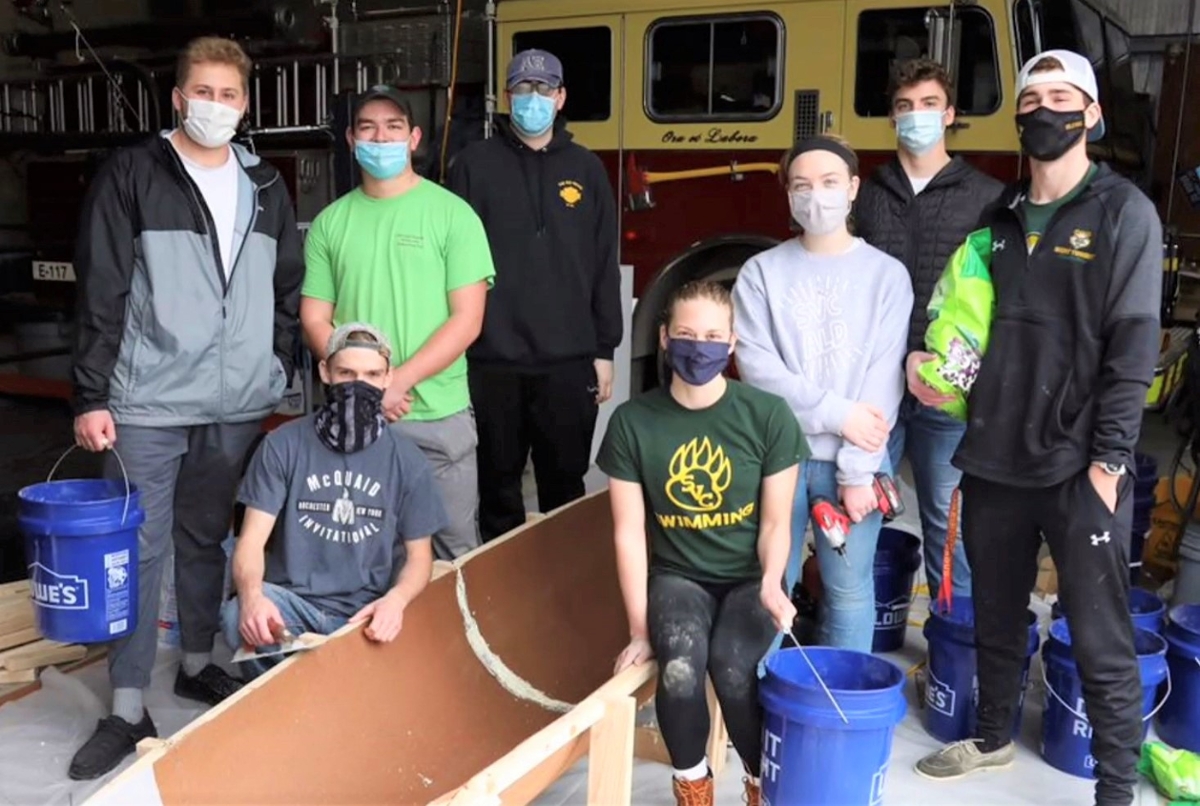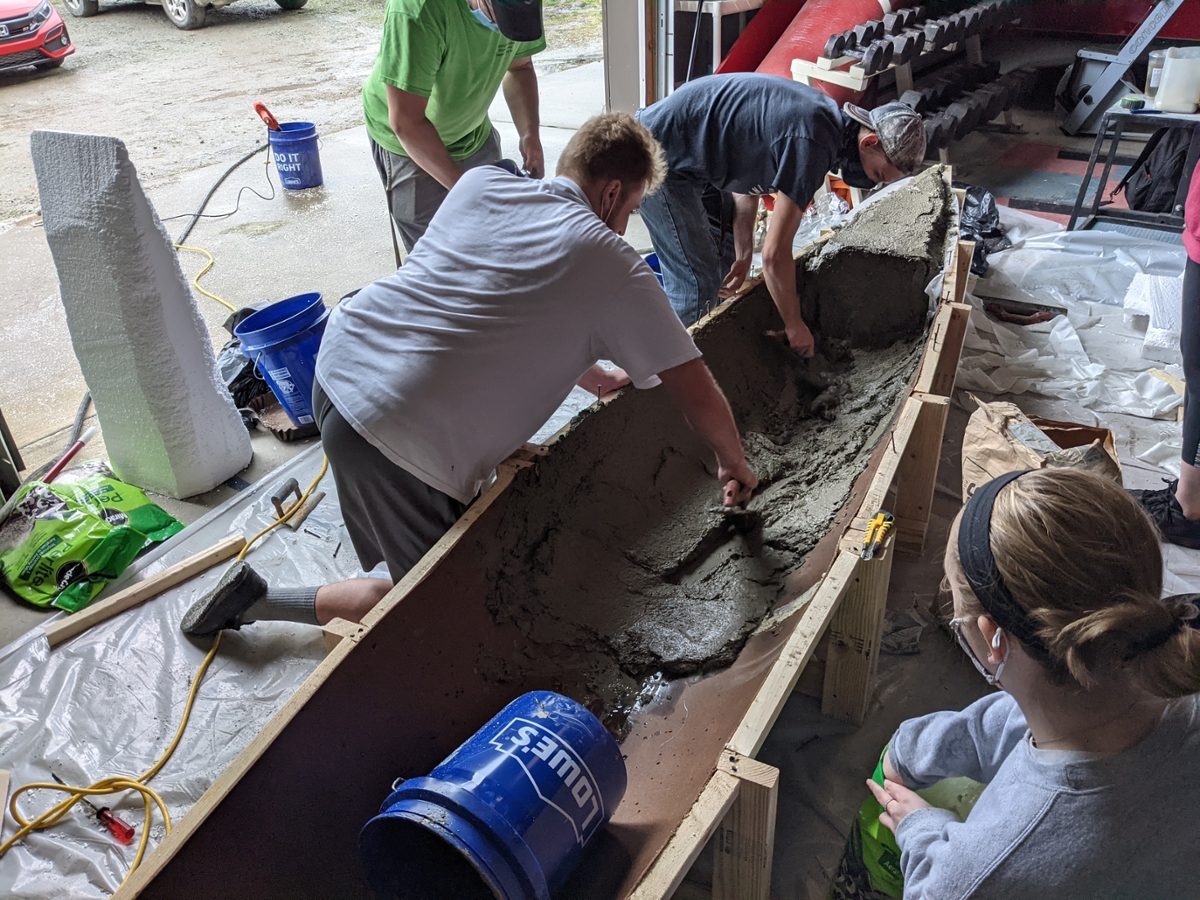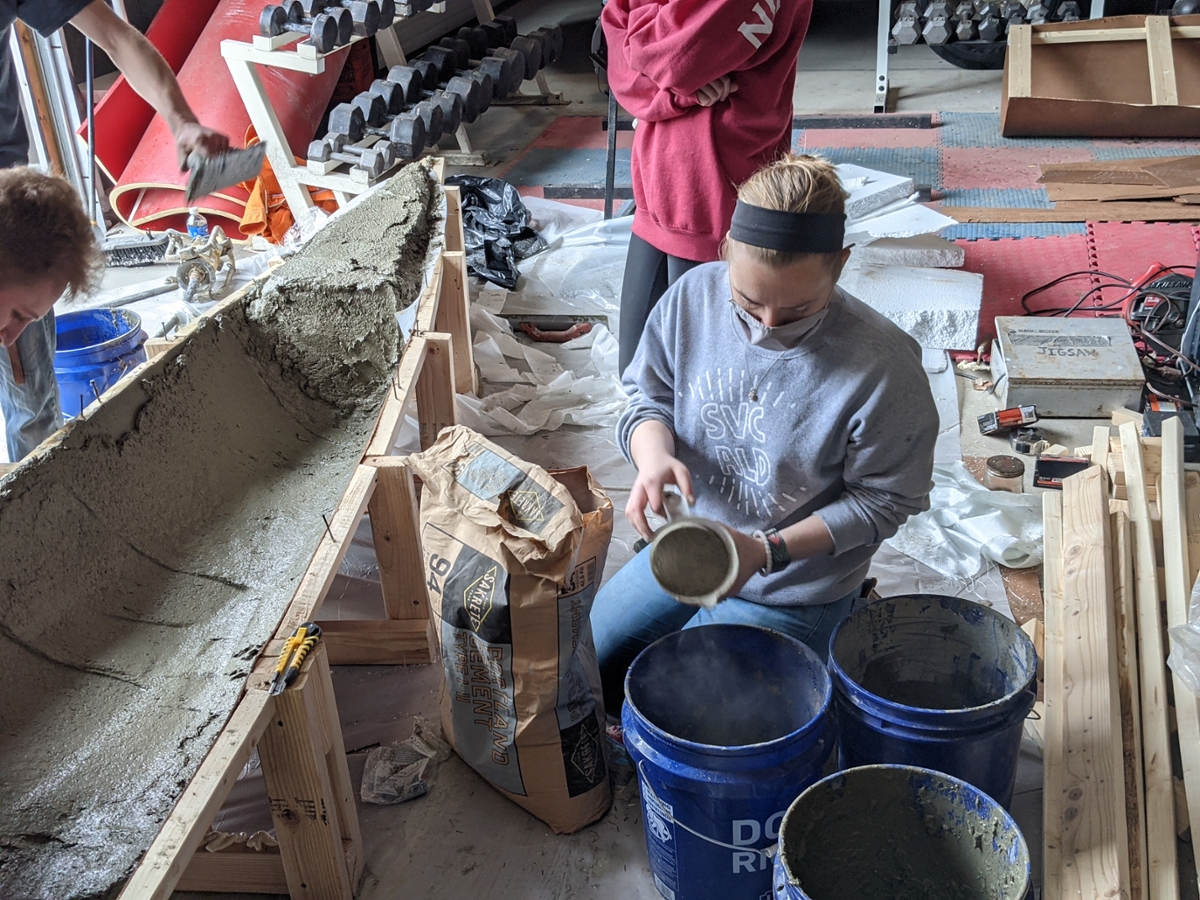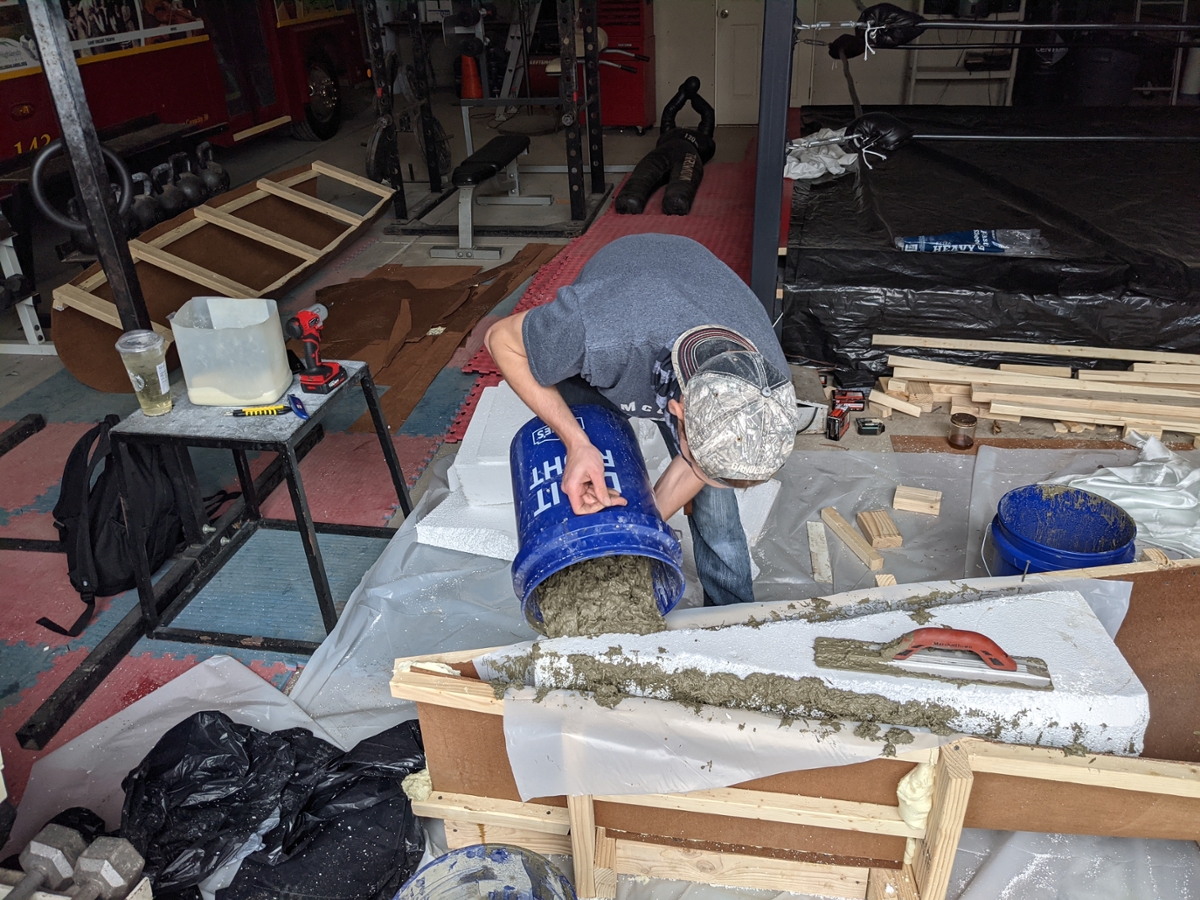Engineering Students Embark on Creating Concrete Canoe
Engineering Students Embark on Creating Concrete Canoe
-
Side Navigation
- Saint Vincent College to Add Academic Programs in Sports Management, Sports and Media
- Saint Vincent College Named Recipient of 'It's On Us PA' Grant for 2021-22
- Saint Vincent College, Mainline Pharmacy Group Form Partnership for Vaccine Distribution
- SVC Plans Virtual Get Acquainted Day for Prospective Students
- Saint Vincent Community Mourns Loss of Mrs. Joanne Rogers
- Saint Vincent College Students Offer Video Tributes to Rev. Dr. Martin Luther King Jr.
- SVC Announces Updated Athletic Spectator Policy
- SVC Community to Celebrate 'Life in Christ' Week
- Fortnight Events to Welcome Students for Spring Semester
- Junior Awarded Inaugural Rev. Nathan J. Munsch, O.S.B., Scholarship
- Music at Midday Series Continues with Vocalist, Pianist Nick Pietrusinski
- Winners of 2021 Rev. Dr. Martin Luther King Jr. Poetry Contest Announced
- Eulalia Books' "Katabasis" Finalist for PEN Award
- Saint Vincent College Announces Winners of Wimmer Scholarship Competition
- SVC to Host Virtual Instant Decision Day
- Bearcat Leadership Series Begins March 17
- An Update from Father Paul on Spring Events, Fall Semester
- Sacred Music to be Featured in Upcoming Music at Midday Installment
- Statement from SVC President Father Paul Taylor on the shootings in Atlanta
- 2021 Honors Convocation at Saint Vincent College
- Eulalia Books Opens Submission Call for Local Poetry Series
- SVC Announces Updated Outdoor Athletic Spectator Policy (March 23)
- Palm Sunday Mass to be Livestreamed
- SVC Junior Selected for International Opera Academy
- SVC Grad Named Artist-in-Residence at Local Studio
- Dr. Sarah Daly to Moderate Panel on Anti-Asian Violence and Hate Crimes
- New Book by SVC Professor Explores Leadership in a Galaxy Far, Far Away
- McCarl Coverlet Gallery to Present Virtual Play April 16
- Virtual Get Acquainted Day Planned April 24
- Jazz Artist John Shannon Next Performer in Music at Midday Series
- 2020-21 Homecoming Court Recognized
- Nursing Simulation Lab Provides Hand-On Experience
- New York Times Features SVC English Professor, Alumna
- SVC Junior Taking Part in GRAMMY U Program
- SVC Community Bands Together in Vaccination Efforts
- Generation Magazine to Launch 2020-21 Issue, Website
- School of AHSS, Philosophy Department to Host Lecture, 'Who Is John Deely?'
- Alumnae Trio Named to '30 Under 30' Listing
- Finalists for 47th Annual President's Award Announced
- Michael B. Downey, C'04, to Deliver Honors Convocation Address
- 18th Annual SVC Academic Conference to Launch Virtually
- Mary R. Anand Named 2021 President's Award Recipient
- Shelter-in-Place Order Lifted
- Thomas Octave Named Recipient of Boniface Wimmer Faculty Award
- Dr. Sarah Daly Receives Quentin Schaut Faculty Award
- Students, Faculty Recognized at Spring Honors Convocation
- Cindy Citrone to Deliver May Commencement Address
- SVC, Fred Rogers Center to Launch Community Programming Series
- Office of Student Affairs Sponsors Art Contest
- Music at Midday Series Continues May 18
- Sixteen Inducted into Pi Mu Epsilon
- SVC, Verostko Center for the Arts Announce 8th Catholic Arts Biennial
- Engineering Students Embark on Creating Concrete Canoe
- Boyer School Graduates to Pursue Graduate Degrees
- SVC Graduates Accepted into Allied Health Programs
- Boyer School Graduates to Attend Professional Health Schools
- Registration Open for 2021 Challenge Program
- Three Hundred Thirty Seven Saint Vincent College Students Awarded Degrees
- 175th Spring Commencement Address
- 175th Spring Commencement Platform Participants
- Public Meeting Notice
- SVC Professor Examines 'Leadership in Middle-earth' in New Book
- Twelve Inducted into Lambda Pi Eta
- Spring 2021 Dean's List Announced
- Board of Directors Elects New Chair
- Fred Rogers Center to Host Virtual Symposium for Educators
- Dr. Lucas Briola Honored by College Theology Society
- Saint Vincent College Celebrates Juneteenth
- Statement on Steelers Training Camp
- McCarl Coverlet Gallery to Present Master Magician Dan Kamin
- Campus Emergency Update: June 28, 2021
- SVC to Host 2021 Western Pennsylvania Drug Summit
- Dr. Dana Winters Named Executive Director of Fred Rogers Center
- Dr. Elaine Bennett Appointed Dean of School of Arts, Humanities and Social Sciences
- SVC Grad Credits Liberal Arts Background for Law School Success
- SVC Student Filmmakers Honored for Unique Project
- Dr. Jerome Foss Honored with Thoburn Excellence in Teaching Award
- Saint Vincent College to Host Major Exploration Day on Nov. 13
- Saint Vincent College Hosts Mock Trial Clinic and Argument Competition
- Boyer School Contingent Travels to Sequoia National Park for Field Research
- New Academic Programs Added for Fall 2021
- SVC, Verostko Center for the Arts to Host 8th Catholic Arts Biennial
- McKenna School to Host Constitution Day Lecture
- Saint Vincent Mourns Loss of Rabbi Jason Edelstein
- McCarl Coverlet Gallery to Present “The Kid at 100,” Featuring Comedian Dan Kamin
- Campus Ministry Holds 9/11 Memorial Service
- On Liberty and Church Streets in Lower Manhattan
- SVC Ranked in Top Tier of National Liberal Arts Colleges by U.S. News and World Report
- Saint Vincent College Announces 2021 Alumni of Distinction
- McKenna School, Center for Political and Economic Thought to Open Lecture Series with U.S. Commissioner of Labor Statistics
- Eulalia Books Publishes New Poetry Translation
- McCarl Coverlet Gallery, Verostko Center for the Arts Partnering with ViVA to Host Virtual Artist Talks
- 2021 Homecoming Court Announced
- McKenna School to Host Conference on Higher Education
- SVC Players to Present 'Clue: On Stage!' Oct. 29-31
- McKenna School to Host Dartmouth Professor
- News 2021
- McKenna School to Host Baylor University Professor
- Dr. Roger F. Malina to Deliver Threshold Lecture
- Saint Vincent Mourns Loss of Father Augustine Flood, O.S.B.
- Saint Vincent Summer Theatre Returns With a Special Christmas Show
- Saint Vincent to Celebrate Founders' Day
- Saint Vincent College Officially Dedicates Verostko Center for the Arts
- Father Philip M. Kanfush Presented with 2021 Projektenmacher Award
- Center for Catholic Thought and Culture Publishes New Academic Journal
- SVC Awards Honorary Degrees
- SVC APB Attends Award Ceremony
- Eulalia Books Announces First Winner of Joe O'Connor Chapbook Prize
- Saint Vincent College Rugby Contingent Chosen for All-Star Event
- SVC English Grad Completes Ph.D. Dissertation
- Evan Frazier to Deliver Commencement Address
- Seventeenth December Commencement Address
- Seventeenth December Commencement Platform Participants
- Saint Vincent College Awards Degrees at December 2021 Commencement

Under the guidance of Dr. Derek Breid, assistant professor of engineering, six seniors – Reese Capo, Danielle Koehler, Michael Moresea, Eric Pennella, D.J. Rossi and Jonas Wudkwych - embarked on a year-long capstone project of building a functioning concrete canoe with the aim of sailing it on Saint Vincent Lake upon its completion.
Breid explained that the project is the product of the Engineering Department’s revamped curriculum, which includes an emphasis on a larger scope, group-based design projects for each students’ required capstone.
 “Last spring,” Breid said, “I met with our junior students to give them an overview of what we’re looking for in a capstone and asked if they had any ideas in mind as far as projects or applications. One of the things I suggested was taking a look at some of the design competitions sponsored by various engineering societies. Over the summer, I heard from two of the students, Danielle and Jonas, who had looked into the concrete canoe competition offered by the American Society of Civil Engineers (ASCE). This seemed like a doable project for where our program is right now and the students seemed really interested in it.”
“Last spring,” Breid said, “I met with our junior students to give them an overview of what we’re looking for in a capstone and asked if they had any ideas in mind as far as projects or applications. One of the things I suggested was taking a look at some of the design competitions sponsored by various engineering societies. Over the summer, I heard from two of the students, Danielle and Jonas, who had looked into the concrete canoe competition offered by the American Society of Civil Engineers (ASCE). This seemed like a doable project for where our program is right now and the students seemed really interested in it.”
Since the beginning of the fall semester, the group has been tasked with every aspect of planning and constructing a functioning canoe. Such a broad project mirrors many real-world engineering projects, which require the cooperation of a group of engineers, each with a different specialty.
“This project brings in a lot of areas of engineering and a lot of concepts that maybe not every student has experience with,” said Breid. “It would give an opportunity for a chemical engineer and a material engineer and a mechanical engineer to all work together.”
He noted that the students concentrating in chemical and material engineering have been working to develop the proper mix of concrete and the process by which it is mixed, poured and cured, while the mechanical engineering students are tasked with analyzing the stresses produced by the canoe supporting its own weight, plus the weight of its occupants, while floating in the water.
 “Part of the requirements,” he said, “is that the students are to analyze the design by modeling these stresses that are going to be put on the canoe and modeling the flotation. This includes measuring the force that the water is putting on the canoe, plus the canoe’s own weight and the weight it will be carrying. Doing mechanical analysis is a big part of it, as they’ll be modeling the stresses that are going to be developed and then work with materials engineers to see if the concrete mix works.”
“Part of the requirements,” he said, “is that the students are to analyze the design by modeling these stresses that are going to be put on the canoe and modeling the flotation. This includes measuring the force that the water is putting on the canoe, plus the canoe’s own weight and the weight it will be carrying. Doing mechanical analysis is a big part of it, as they’ll be modeling the stresses that are going to be developed and then work with materials engineers to see if the concrete mix works.”
Wudkwych, whose focus is mechanical engineering, has enjoyed working in a group setting and has been fascinated by watching the progress made.
“It has been great having a group of students with such different interests and knowledge working together. My focus has been working on the hull shape of the canoe and ensuring that it will float. We have two basic groups – the chemical and material engineering students are focused on the concrete mixture, while the mechanical students are working on the physical hull design. It has been really interesting applying the knowledge gained from school to a real-world problem.”
Koehler, who also has a mechanical engineering focus, said that projects like this are what initially drew her to the engineering field.
“My favorite aspect is watching the canoe become alive,” she said. “Taking an idea and building it is why I became an engineer in the first place. I have come up with so many designs, but have never actually built them. Now, I have the opportunity to bring an idea to life. We all intend to be paddling in Saint Vincent Lake before the end of the semester.”
The group met twice a week during the first semester to conduct research, test concrete mixtures and create the design of the canoe. They plan to move into the building stage in February and have the canoe ready to test by the early spring. While they are proud to be the first Saint Vincent contingent to take part in the concrete canoe capstone, Wudkwych and Koehler said that being the pioneers also comes with some challenges.
“We don’t have anyone that we can readily ask who actually has experience working on a concrete canoe,” said Wudkwych. “While we can research other schools in past competitions, it isn’t a replacement for actually experiencing completing a build.”
Koehler agreed, saying that it’s difficult to know whether the group is always on the right track, but she has faith in her and her colleagues’ work.
“We feel that we have put in a lot of effort up to this point and are confident that it will work out as planned.”
 Though they may be the first SVC group to take part in the concrete canoe capstone, they don’t plan to be the last and have recruited a trio of underclass engineering majors in juniors Anthony Berardelli and Zachary Kuzel and sophomore Cara Luallen to help in this year’s project while gaining invaluable experience for the future.
Though they may be the first SVC group to take part in the concrete canoe capstone, they don’t plan to be the last and have recruited a trio of underclass engineering majors in juniors Anthony Berardelli and Zachary Kuzel and sophomore Cara Luallen to help in this year’s project while gaining invaluable experience for the future.
“We felt if we invited underclassmen to join the project,” said Koehler, “the project could continue in the coming years.”
The students followed rules and parameters from previous ASCE concrete canoe competitions and are planning to form a chapter of the society at Saint Vincent, which will enable SVC to take part in future competitions. While they may not get to showcase this year’s project on a national level, Breid feels that the students are amassing significant hands-on experience that will prove invaluable for their future.
“This gives students experience in teamwork, designing, planning, building and testing,” he said. “We talk about career readiness and how to talk about yourself in interviews. How are they going to set themselves apart in an interview from someone who may have gone to a larger school? This capstone project is one of the ways. It’s something that’s pretty unique here.”
---
FOLLOW SAINT VINCENT COLLEGE ON SOCIAL MEDIA!
Twitter: @MySaintVincent
Facebook: http://www.facebook.com/saintvincentcollege
Instagram: @SaintVincentCollege
YouTube: Saint Vincent College
